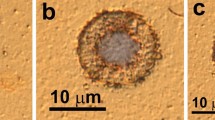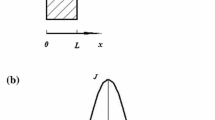Abstract
Effects of different parameters on the melting, vaporization and resolidification processes of thin gold film irradiated by femtosecond pulses and pulse train were systematically studied. The classical two-temperature model was adopted to depict the non-equilibrium heat transfer in electrons and lattice. The melting and resolidification processes, which was characterized by the solid-liquid interfacial velocity, as well as elevated melting temperature and depressed solidification temperature, was obtained by considering the interfacial energy balance and nucleation dynamics. Vaporization process which leads to ablation was described by tracking the location of liquid-vapor interface with an iterative procedure based on energy balance and gas kinetics law. The parameters in discussion included film thickness, laser fluence, pulse duration, pulse number, repetition rate, pulse train number, etc. Their effects on the maximum lattice temperature, melting depth and ablation depth were discussed based on the simulation results.
Similar content being viewed by others
References
Wang G X, Prasad V. Microscale heat and mass transfer and non-equilibrium phase change in rapid solidification. Materials Science and Engineering A, 2000, 292(2): 142–148
Hohlfeld J, Wellershoff S S, Gudde J, Conrad U, Jahnke V, Matthias E. Electron and lattice dynamics following optical excitation of metals. Chemical Physics, 2000, 251(1–3): 237–258
Groeneveld R H M, Sprik R, Lagendijk A. Femtosecond spectroscopy of electron-electron and electron-phonon energy relaxation in Ag and Au. Physical Review B: Condensed Matter and Materials Physics, 1995, 51(17): 11433–11445
Furukawa H, Hashida M. Simulation on femto-second laser ablation. Applied Surface Science, 2002, 197-198: 114–117
Furusawa K, Takahashi K, Kumagai H, Midorikawa K, Obara M. Ablation characteristics of Au, Ag, and Cu metals using a femtosecond Ti: Sapphire laser. Applied Physics A, Materials Science & Processing, 1999, 69(7): S359–S366
Corkum P B, Brunel F, Sherman N K, Srinivasan-Rao T. Thermal response of metals to ultrashort-pulse laser excitation. Physical Review Letters, 1988, 61(25): 2886–2889
Anisimov S I, Kapeliovich B L, Perel’man T L. Electron emission from metal surfaces exposed to ultra-short laser pulses. Soviet Physics, JETP, 1974, 39(2): 375–377
Qiu T Q, Tien C L. Heat transfer mechanisms during short-pulse laser heating of metals. ASME Journal of Heat Transfer, 1993, 115(4): 835–841
Tzou D Y. Macro- to Microscalse Heat Transfer. Washington, D.C.: Taylor & Francis, 1997
Tzou D Y. Computational techniques for microscale heat transfer. In: Minkowycz W J, Sparrow E M, Murthy J Y, eds. Handbook of Numerical Heat Transfer. 2nd ed. Hoboken, NJ: Wiley, 2006
Jiang L, Tsai H L. Improved two-temperature model and its application in ultrashort laser heating of metal films. Journal of Heat Transfer, 2005, 127(10): 1167–1173
Chen J K, Tzou D Y, Beraun J E. A semiclassical two-temperature model for ultrafast laser heating. International Journal of Heat and Mass Transfer, 2006, 49(1,2): 307–316
Von der Linde D, Fabricius N, Danielzik B, Bonkhofer T. Solid phase superheating during picosecond laser melting of gallium arsenide. In: Materials Research Society Symposia Proceedings. Pittsburgh, PA: Materials Research Society, 1986
Zhang Y, Chen J K. An interfacial tracking method for ultrashort pulse laser melting and resolidification of a thin metal film. Journal of Heat Transfer, 2008, 130(6): 062401–062410
Chen J K, Latham W P, Beraun J E. The role of electron-phonon coupling in ultrafast laser heating. Journal of Laser Applications, 2005, 17(1): 63–68
Chowdhury I H, Xu X. Heat transfer in femtosecond laser processing of metal. Numerical Heat Transfer. Part A: Applications, 2003, 44(3): 219–232
Anisimov S I, Rethfeld B. Theory of ultrashort laser pulse interaction with a metal. In: Konov V I, Libenson M N, eds. Proceedings Of SPIE Vol 3093, St. Petersburg-Pushkin, Russia, 1997
Kuo L S, Qiu T. Microscale energy transfer during picosecond laser melting of metal films. In: ASME Natl Heat Transfer Conf, Baltimore, 1996
Klemens P G, Williams R K. Thermal conductivity of metals and alloys. Int Metals Reviews, 1986, 31(5): 197–215
Faghri A, Zhang Y. Transport Phenomena in Multiphase Systems. Burlington, MA: Elsevier Academic Press, 2006
Xu X, Chen G, Song K H. Experimental and numerical investigation of heat transfer and phase change phenomena during excimer laser interaction with nickel. International Journal of Heat and Mass Transfer, 1999, 42(8): 1371–1382
Birks N, Meier G H, Pettit F S. Introduction to the High-Temperature Oxidation of Metals, 2nd ed. Cambridge: Cambridge University Press, 2006
Akhatov I, Lindau O, Topolnikov A, Mettin R, Vakhitova N, Lauterborn W. Collapse and rebound of a laser-induced cavitation bubble. Physics of Fluids, 2001, 13(10): 2805–2819
Huang J, Zhang Y, Chen J K. Ultrafast solid-liquid-vapor phase change in a thin gold film irradiated by multiple femtosecond laser pulses. International Journal of Heat and Mass Transfer, 2009, 52(13-14): 3091–3100
Huang J, Zhang Y, Chen J K. Ultrafast solid-liquid-vapor phase change of a gold film induced by pico-to femtosecond lasers. Applied Physics A, Materials Science & Processing, 2009, 95(3): 643–653
Patankar S. Numerical Heat Transfer and Fluid Flow. New York: Taylor & Francis, 1980
Author information
Authors and Affiliations
Corresponding author
Additional information
Dr. Yuwen Zhang is a Professor in the Department of Mechanical and Aerospace Engineering at University of Missouri. His research interests are in the areas of thermalfluids science and engineering, including ultrafast and high-energy laser materials interaction, multiscale transport phenomena in multiphase systems, inverse problems and optimization under uncertainty, micro- and nanoscale heat transfer, and sustainable and renewable energy. His research has been funded by the Office of Naval Research, Air Force Research Laboratory, Army Program Executive Office, and National Science Foundation (NSF), as well as the National Natural Science Foundation of China. He is author of two books, 150 journal articles, and more than 100 conference papers. His innovative works have earned him many awards including the 2002 Young Investigator Award from the Office of Naval Research and the 2010 Chancellor’s Award for Outstanding Research and Creative Activity from the University of Missouri. Professor Zhang has been awarded a 2008 Chang Jiang Chair Professorship by the Ministry of Education of China.
Rights and permissions
About this article
Cite this article
Huang, J., Zhang, Y., Chen, J.K. et al. Ultrafast solid-liquid-vapor phase change of a thin gold film irradiated by femtosecond laser pulses and pulse trains. Front. Energy 6, 1–11 (2012). https://doi.org/10.1007/s11708-012-0179-9
Received:
Accepted:
Published:
Issue Date:
DOI: https://doi.org/10.1007/s11708-012-0179-9




